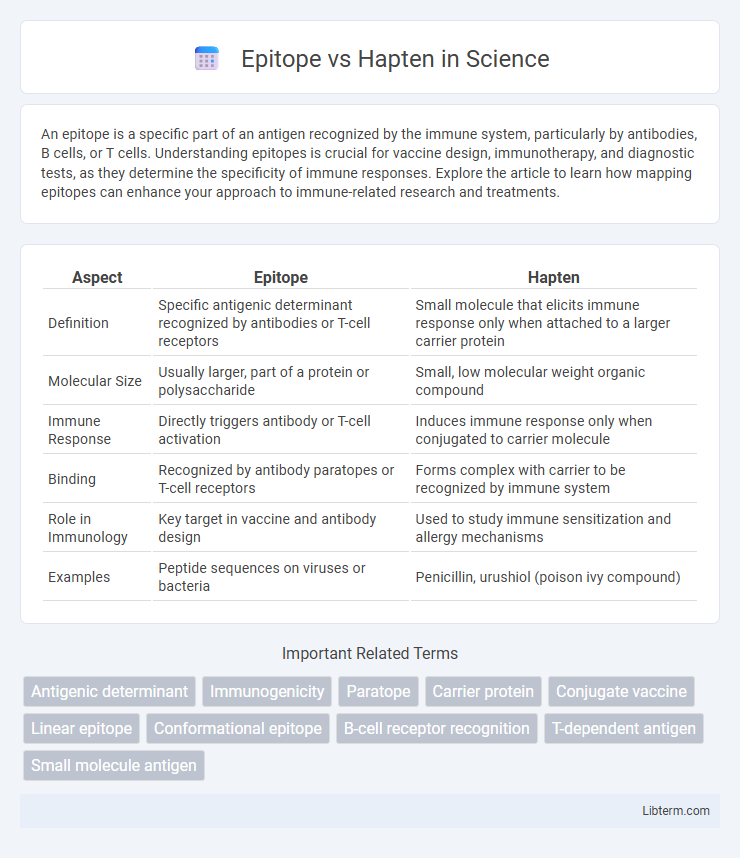An epitope is a specific part of an antigen recognized by the immune system, particularly by antibodies, B cells, or T cells. Understanding epitopes is crucial for vaccine design, immunotherapy, and diagnostic tests, as they determine the specificity of immune responses. Explore the article to learn how mapping epitopes can enhance your approach to immune-related research and treatments.
Table of Comparison
| Aspect | Epitope | Hapten |
|---|---|---|
| Definition | Specific antigenic determinant recognized by antibodies or T-cell receptors | Small molecule that elicits immune response only when attached to a larger carrier protein |
| Molecular Size | Usually larger, part of a protein or polysaccharide | Small, low molecular weight organic compound |
| Immune Response | Directly triggers antibody or T-cell activation | Induces immune response only when conjugated to carrier molecule |
| Binding | Recognized by antibody paratopes or T-cell receptors | Forms complex with carrier to be recognized by immune system |
| Role in Immunology | Key target in vaccine and antibody design | Used to study immune sensitization and allergy mechanisms |
| Examples | Peptide sequences on viruses or bacteria | Penicillin, urushiol (poison ivy compound) |
Understanding Epitopes: Definition and Importance
Epitopes, also known as antigenic determinants, are specific regions on an antigen recognized by antibodies or T-cell receptors, playing a crucial role in immune response specificity. These molecular structures range from 5 to 8 amino acids in peptides or specific sugar moieties in polysaccharides, enabling precise immune targeting. Understanding epitopes is fundamental for vaccine design, immunotherapy development, and diagnostic test accuracy in immunology.
What is a Hapten? A Brief Overview
A hapten is a small molecule that, by itself, is not immunogenic but can elicit an immune response only when attached to a larger carrier protein. Unlike epitopes, which are specific parts of antigens recognized directly by antibodies or T-cell receptors, haptens require conjugation to a protein to be recognized by the immune system. Haptens are crucial in immunology for designing vaccines, studying allergic reactions, and developing diagnostic tools.
Structural Differences Between Epitopes and Haptens
Epitopes are specific molecular regions on antigens that are recognized by antibodies or T-cell receptors, typically composed of a series of amino acids or sugar residues forming a three-dimensional structure. Haptens are small molecules that, due to their low molecular weight, cannot elicit an immune response independently but become antigenic only when covalently attached to a larger carrier protein, creating a new epitope. The primary structural difference lies in epitopes being inherent parts of larger antigenic molecules, whereas haptens are distinct small molecules requiring conjugation to a carrier to form an immunogenic complex.
Role of Epitopes in Immune Recognition
Epitopes are specific molecular regions on antigens that are recognized by antibodies or T-cell receptors, playing a crucial role in immune system targeting and response initiation. Unlike haptens, which are small molecules that must bind to a larger carrier protein to become immunogenic, epitopes directly trigger immune recognition by interacting with immune receptors. This precise binding between epitopes and immune cells enables selective detection and neutralization of pathogens, orchestrating adaptive immunity.
Hapten’s Mechanism in Immune Response
Haptens are small molecules that, by themselves, are not immunogenic but become capable of eliciting an immune response when covalently attached to larger carrier proteins, forming a hapten-carrier complex that the immune system recognizes as foreign. This complex is processed by antigen-presenting cells and presented to T cells, triggering B cell activation and the production of antibodies specific to the hapten. The hapten mechanism underlies important immunological phenomena such as drug allergies and contact hypersensitivity, where the immune system targets hapten-modified self-proteins.
Epitope Mapping and Its Applications
Epitope mapping identifies the specific antigenic sites recognized by antibodies or T-cell receptors, crucial for vaccine design, diagnostic development, and therapeutic antibody production. This process employs techniques such as X-ray crystallography, peptide scanning, and computational modeling to precisely locate linear and conformational epitopes on antigens. Understanding epitope structure and function enables targeted immunotherapy, improved autoimmune disease diagnostics, and the creation of more effective vaccines.
Hapten-Carrier Conjugates: Formation and Function
Hapten-carrier conjugates form when small molecules called haptens chemically bind to larger carrier proteins, creating a complex capable of eliciting an immune response. This conjugation enables the immune system to recognize the hapten as part of a foreign antigen, facilitating antibody production against the hapten. The formation and function of hapten-carrier conjugates are critical in vaccine development, immunodiagnostics, and the study of allergic reactions.
Clinical Relevance: Epitopes vs Haptens in Allergy and Immunotherapy
Epitopes, the specific molecular sites on antigens recognized by antibodies, play a crucial role in allergy diagnosis and immunotherapy by targeting immune responses to allergens. Haptens, small molecules that become antigenic only when bound to carrier proteins, are significant in drug-induced allergies and can trigger hypersensitivity reactions. Understanding the distinction between epitopes and haptens informs the design of precise immunotherapeutic strategies, improving allergy treatment outcomes and minimizing adverse reactions.
Diagnostic and Therapeutic Uses of Epitopes and Haptens
Epitopes, the specific parts of antigens recognized by antibodies, play a critical role in diagnostic assays like ELISA and immunohistochemistry for disease detection and monitoring. Haptens are small molecules that, when conjugated to larger carriers, elicit an immune response and are used in developing vaccines and allergy testing. Therapeutically, epitopes guide monoclonal antibody design for targeted treatments, whereas haptens aid in creating specific immunogens to modulate immune responses.
Key Differences: Epitope vs Hapten at a Glance
Epitope is the specific part of an antigen recognized by antibodies or T-cell receptors, typically composed of a few amino acids or sugar residues, whereas hapten is a small molecule that cannot elicit an immune response alone but becomes immunogenic when attached to a larger carrier protein. Key differences include size and immunogenicity: epitopes are naturally immunogenic segments of antigens, while haptens require conjugation to carriers to induce antibody production. Understanding these distinctions is crucial for vaccine design, antibody production, and diagnostic applications.
Epitope Infographic

 libterm.com
libterm.com